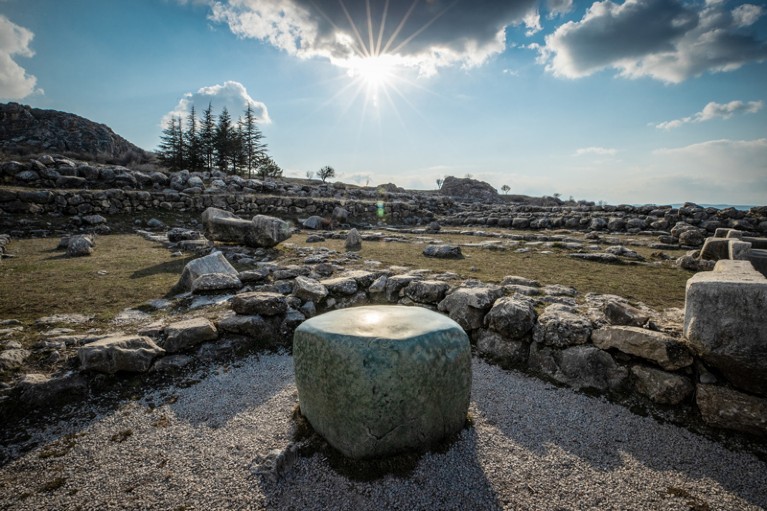
The ruins of the Hittite capital, Hattusa, which could have been abandoned following a long drought.Credit: Ali Balikci/Anadolu Agency/Getty
The ancient Anatolian empire of the Hittites mysteriously collapsed more than 3,000 years ago. Now, researchers find that climate change could have played a part.
A study that ties together climate observations and human history suggests that a three-year drought in central Anatolia from 1198 to 1196 bc contributed to the demise of the empire’s capital, Hattusa, perhaps dooming the civilization.
The study, published in Nature on 8 February1, found reduced tree growth in central Anatolia, which the authors attribute to a decrease in local rainfall during the twelfth century bc. They identified three consecutive years of drought from 1198 to 1196 bc — rare but not unheard of in the central Anatolian climate — which synchronize with the abandonment of the Hittite capital and the fall of the empire.
“One year of real drought across a large area wrecks lives even in the modern world,” says Sturt Manning, an archaeologist at Cornell University in Ithaca, New York, and a co-author of the paper. But in the pre-modern world, a third consecutive year of drought would mean “no food, no taxes, no ability to feed the army”, he says, and could undermine any civilization.
Societal collapse
The Hittite empire dominated most of Anatolia — the peninsula that roughly corresponds to the Asian part of modern Turkey — and parts of northern Syria between 1650 and 1200 bc. It collapsed shortly after 1200 bc, with no historical records of Hittite rulers after King Suppiluliuma II, who came to rule in 1207 bc.
The capital Hattusa, in Turkey’s Çorum province in central Anatolia, was the primary home of the gods of the Hittite world. “It was both a spiritual and political centre,” says Manning. But around 1200 bc, Hattusa was abandoned and emptied of its people, and was later burnt down.
The authors examined historical records of juniper trees that grew during the period from 1775 bc to 748 bc at the site of Gordion in central Anatolia, 230 kilometres west of Hattusa. Their analysis included 23 samples of 18 tree rings from ancient timbers excavated at Gordion. The authors identified narrow ring growth in the trees with no indication of fire or insect attack, suggesting that the reduced growth was the result of decreased rainfall in late spring and summer.
To evaluate the frequency of droughts in the region and understand their spatial extent, the authors then looked at modern climate records between 1929 and 2009 from the meteorological station nearest to Gordian. They found that in roughly 1 of every 15 of the years, the annual rainfall was less than 250 millimetres — below the 300-mm minimum level of rainfall required to grow barley or wheat in the region.
Combining the tree-ring data and the climate records, the authors identified an abrupt drought that occurred in three consecutive years from 1198 to 1196 bc.
“We’re not saying the climate solely caused the collapse of the Hittites,” says Manning. The Hittite people could have weathered a drought by switching to different crops, for example. “Humans are incredibly good, if they want to be, at being resilient,” he says.
The Hittites also planned for droughts, and tended to build water reservoirs next to their cities, says Alan Greaves, an archaeologist at the University of Liverpool, UK. “It shows an awareness of the fact that there are going to be dry periods.”
But a drought that went on for more than two years would have stressed food resources, undermined the economic and political force of the empire and made it vulnerable to attack by other empires.
Dominik Fleitmann, a palaeoclimatologist at the University of Basel in Switzerland, finds the drought hypothesis plausible. “Even with a good system and good adaptation to drought, this was simply too much to cope with.” And the picture matches other sources of evidence, he adds. “We have all the documents saying that there are famines in the Hittite empire.”
“They just weren’t politically or economically prepared for that particular drought,” says Greaves. The droughts could have accelerated the decision to move the capital away from Hattusa to a new capital called Tarhuntassa, says Greaves. Archaeologists are still searching for the ruins of that new capital, he adds.
Mega-drought?
But for Harvey Weiss, an archaeologist at Yale University in New Haven, Connecticut, focusing on the evidence from those three years misses a bigger picture. In his view, the paper “misrepresents the climate history of that period”, he says.
Instead, Weiss says an initial drought event occurred around 1190 and was the beginning of a 200-year mega-drought with 30% reduction in winter rainfall2. “Two or three years of drought are not much, but an abrupt mega-drought with high magnitude creates cascading effects” says Weiss. The mega-drought extended from Spain through the Mediterranean and Turkey, all the way to India, adds Weiss.
But the evidence for such a mega-drought is “approximate, unlike annual tree-ring-based data”, says Manning. And several societies that existed alongside the Hittites did not disappear at that time, he adds. “The end of the Hittite empire does not mean total collapse everywhere in the Near East — not even uniformly all over Anatolia.”
More tree-ring data could help to settle the question. “What we need is a network of similar records to understand the spatial extent of the drought, and also, maybe, to have a complete picture,” says Fleitmann.
Future research should also consider the migration of people to areas that were more resilient to the drought, he says.

